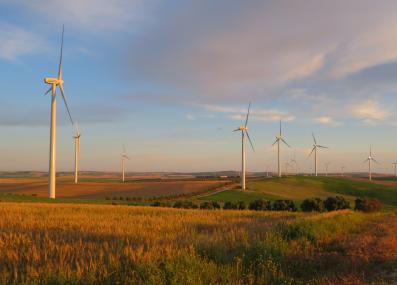Have a question?
Would getting all our electricity from wind and solar power raise the price of electricity?
Yes—wind and solar are cheap and getting cheaper, but they do make the grid more complicated in ways that, today, would make electricity more expensive if we relied on them exclusively.
May 30, 2023
Making electricity from renewable sources such as solar and wind, rather than by burning fossil fuels like coal and gas, is crucial to address climate change. Would switching entirely to these clean energy sources raise the price of electricity? Yes—at least if you don’t count the cost of the environmental damage caused by fossil fuels, says Richard Schmalensee, MIT’s Howard W. Johnson Professor of Management Emeritus, Professor of Economics Emeritus, and Dean Emeritus of the MIT Sloan School of Management.
Schmalensee says the main problem is the “intermittent” nature of wind and sunshine. We’re used to matching electricity supply and demand moment-to-moment by burning as much fossil fuel as we need. Renewable sources just don’t work that way. “You get what you get when nature gives it to you,” Schmalensee says. “That's just a more complicated system, and it's not going to be cheaper.”
This isn’t a major problem for today’s electric grid, in which renewables make up only a small share of electricity. In fact, building and operating renewables can often be less expensive because the costs of solar and wind have plummeted. This is what people mean when they say solar and wind are cheaper than fossil fuels: averaged over their lifetime, the price of solar or wind energy per kilowatt-hour is lower than coal or gas power.1
But if renewables provide most or all of our electricity, then we need a plan for what to do when they aren’t making electricity. That probably means energy storage, storing lots of solar or wind energy when it’s plentiful to use when it’s not—and storage is not cheap.
“If you could costlessly store electricity, you might argue that getting it all from wind and solar might save money,” Schmalensee says. “But you can't.”
Today, most of the grid’s energy storage capacity is in “pumped storage hydropower”: when we have lots of energy, some of it is used to pump water uphill. When we need more, the water is released to flow downhill through a hydropower turbine. Someday, Schmalensee says, batteries, too, will help to balance the grid. The current electric vehicle (EV) revolution should bring down the cost of batteries because of the need to build so many. It’s also possible, he says, that when most Americans have a big battery in their cars or a backup battery in their homes, that storage capacity could help balance the grid as a whole.
Until then, the best way to work around the variable nature of renewable energy is through economic incentives—which means electricity might get more expensive when there’s less of it. Imagine a scenario, Schmalensee says, in which we get most of our energy from solar. The supply of electricity wanes as the sun goes down in the evening, exactly when many people get home from work and want to run their air conditioners and charge their EVs. (This happens in solar-heavy California, where the state has run advertisements asking people to use less energy between 4 and 9 p.m.2) By charging more for electricity at peak hours, and less at midday when the sun shines brightly, we can nudge people to do things like charge their cars at work, lessening the need for expensive energy storage.
Even if energy storage becomes more affordable, running an electric grid entirely on solar and wind is always going to be more complicated than what we have now, Schmalensee says. For that reason, we may need climate-friendly energy sources we can turn on and off at will—whether that’s coal or gas plants fitted with carbon capture technology, or something new like small nuclear plants. The more of these backup sources we have, the more we can rely on low-cost solar and wind energy at their peak generation times.
And though a completely wind- and solar-powered grid can’t compete with the out-of-pocket costs of fossil fuels, that’s only because the price of coal and gas doesn’t incorporate the damage caused to the planet and humanity by filling up the atmosphere with carbon dioxide. “If you take into account the total cost of running a system that puts CO2 into the air, [then renewables] will be cheaper,” Schmalensee says.
Thank you to several readers for sending in related questions, including George Walchuk of Annandale, New Jersey, Barry Davis of York, Maine, and Holger Piekenbrock of Germany. You can submit your own question to Ask MIT Climate here.
1 International Energy Agency: Projected Costs of Generating Electricity 2020. December 2020.
2 Energy Upgrade California: Time of Use. Accessed May 30, 2023.










